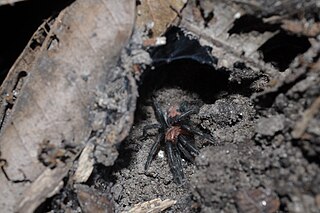
The Goliath birdeater belongs to the tarantula family Theraphosidae. Found in northern South America, it is the largest spider in the world by mass – 175 g (6.2 oz) – and body length – up to 13 cm (5.1 in) – but it is second to the giant huntsman spider by leg span. It is also called the Goliath bird-eating spider; the practice of calling theraphosids "bird-eating" derives from an early 18th-century copper engraving by Maria Sibylla Merian that shows one eating a hummingbird. Despite the spider's name, it only rarely preys on birds.

Brachypelma is a genus of spiders in the family Theraphosidae (tarantulas). They may have bodies up to 6 cm long with legs of similar or greater lengths. Some species have brightly colored legs, with red or orange marks and rings.

Tarantulas comprise a group of large and often ″hairy″ spiders of the family Theraphosidae. Currently, about 1,000 species have been identified. The term tarantula is usually used to describe members of the family Theraphosidae, although many other members of the same infraorder (Mygalomorphae) are commonly referred to as "tarantulas" or "false tarantulas". Some of the more common species have become popular in the exotic pet trade. Many New World species kept as pets have urticating hairs that can cause irritation to the skin, and in extreme cases, cause damage to the eyes.
Neischnocolus is a genus of spiders in the family Theraphosidae. It was first described in 1925 by Petrunkevitch. The genus Ami was separately described in 2008, but was later discovered to be a junior synonym of Neischnocolus. Species are native to Central America and northern South America.

Davus pentaloris is a species of New World tarantula native to Mexico and Guatemala. Davus was at one time considered to be a synonym of Cyclosternum, and its species were placed in that genus, but this is no longer accepted.

The Theraphosinae are a large subfamily of Mygalomorphae spiders in the family Theraphosidae found in the Neotropical realm.

Citharacanthus is a genus of New World tarantulas. They are found in Central America and the Antilles.
Rogério Bertani is a Brazilian arachnologist, active at the Butantan Institute.

Neoheterophrictus is a genus of tarantula in the family Theraphosidae. It comprises seven species, all found in India.

Aphonopelma iodius is a species of spider in the tarantula family Theraphosidae, found in United States. A 1997 paper combined it with three other previously described species into a single species, calling it "A. iodium". However, iodius is a neuter comparative adjective and is the correct form. Aphonopelma smithii has also been synonymized with A. iodius. A. iodius is common in the Mojave Desert to the west of the Colorado River. As of 1997, the distribution of A. iodius farther south or west into the Mojave Desert or North into Nevada and Utah was undetermined.

Nhandu is a genus of South American tarantulas that was first described by S. Lucas in 1983. It was synonymized with Brazilopelma in 2001.

Davus, also known as the tiger rump tarantulas, is a genus of spiders in the family Theraphosidae (tarantulas). It was formerly included in Cyclosternum.
Crassicrus is a genus of Central and South American tarantulas that was first described by S. B. Reichling & R. C. West in 1996.

Cyrtopholis is a genus of tarantulas that was first described by Eugène Louis Simon in 1892.
Antillena is a genus of spiders in the family Theraphosidae (tarantulas). As of March 2017, the genus contained a single species, Antillena rickwesti, found in the Dominican Republic.

Tliltocatl sabulosus is a species of spider in the family Theraphosidae (tarantulas), found in Guatemala.
Ceratogyrus marshalli, also known as straight horned baboon or great horned baboon, is a species of tarantula from the genus Ceratogyrus. It is found in Zimbabwe and Mozambique.

Tliltocatl is a genus of spiders in the tarantula family Theraphosidae. It was split off from Brachypelma in 2020. Species in Tliltocatl are found predominantly in Mexico, with some species native to Central America. They are large burrowing tarantulas, without the striking red leg markings of Brachypelma species.
Tliltocatl alvarezi is a possible species of spider in the family Theraphosidae (tarantulas). The World Spider Catalog regards it as a nomen dubium. The original description, as Citharacanthus alvarezi, was based on a specimen said to be a female, but this is now regarded as a juvenile male. It was transferred to Tliltocatl in 2020.












